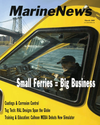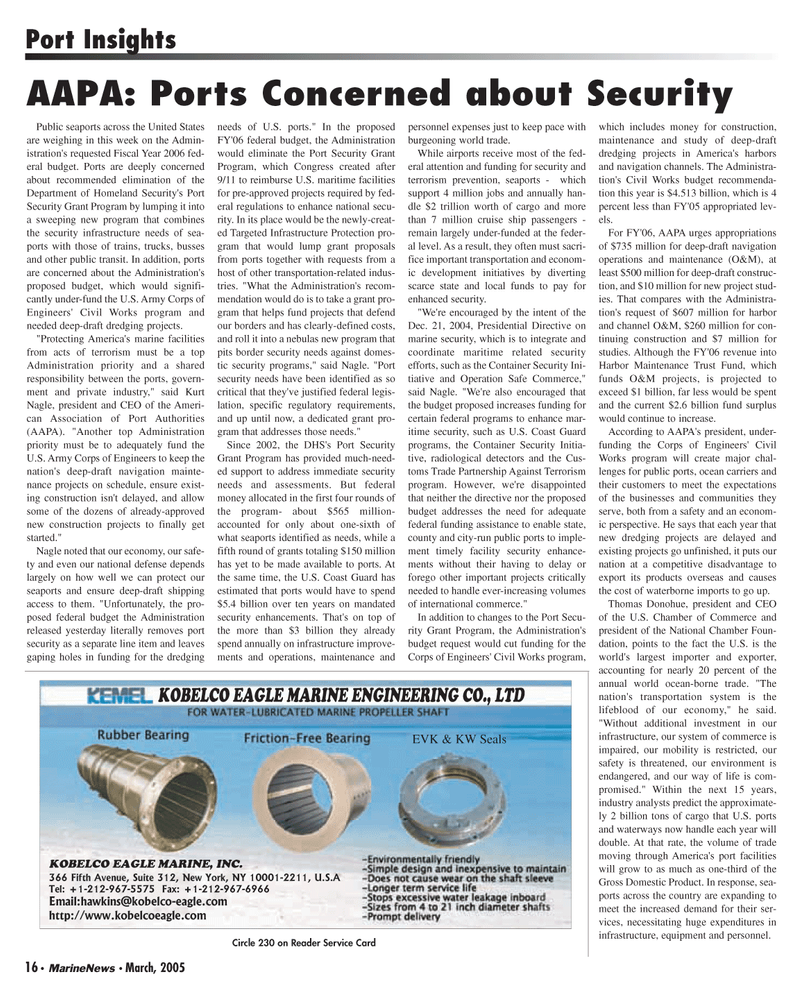
Page 16: of Marine News Magazine (March 2005)
Read this page in Pdf, Flash or Html5 edition of March 2005 Marine News Magazine
16 • MarineNews • March, 2005
Public seaports across the United States are weighing in this week on the Admin- istration's requested Fiscal Year 2006 fed- eral budget. Ports are deeply concerned about recommended elimination of the
Department of Homeland Security's Port
Security Grant Program by lumping it into a sweeping new program that combines the security infrastructure needs of sea- ports with those of trains, trucks, busses and other public transit. In addition, ports are concerned about the Administration's proposed budget, which would signifi- cantly under-fund the U.S. Army Corps of
Engineers' Civil Works program and needed deep-draft dredging projects. "Protecting America's marine facilities from acts of terrorism must be a top
Administration priority and a shared responsibility between the ports, govern- ment and private industry," said Kurt
Nagle, president and CEO of the Ameri- can Association of Port Authorities (AAPA). "Another top Administration priority must be to adequately fund the
U.S. Army Corps of Engineers to keep the nation's deep-draft navigation mainte- nance projects on schedule, ensure exist- ing construction isn't delayed, and allow some of the dozens of already-approved new construction projects to finally get started."
Nagle noted that our economy, our safe- ty and even our national defense depends largely on how well we can protect our seaports and ensure deep-draft shipping access to them. "Unfortunately, the pro- posed federal budget the Administration released yesterday literally removes port security as a separate line item and leaves gaping holes in funding for the dredging needs of U.S. ports." In the proposed
FY'06 federal budget, the Administration would eliminate the Port Security Grant
Program, which Congress created after 9/11 to reimburse U.S. maritime facilities for pre-approved projects required by fed- eral regulations to enhance national secu- rity. In its place would be the newly-creat- ed Targeted Infrastructure Protection pro- gram that would lump grant proposals from ports together with requests from a host of other transportation-related indus- tries. "What the Administration's recom- mendation would do is to take a grant pro- gram that helps fund projects that defend our borders and has clearly-defined costs, and roll it into a nebulas new program that pits border security needs against domes- tic security programs," said Nagle. "Port security needs have been identified as so critical that they've justified federal legis- lation, specific regulatory requirements, and up until now, a dedicated grant pro- gram that addresses those needs."
Since 2002, the DHS's Port Security
Grant Program has provided much-need- ed support to address immediate security needs and assessments. But federal money allocated in the first four rounds of the program- about $565 million- accounted for only about one-sixth of what seaports identified as needs, while a fifth round of grants totaling $150 million has yet to be made available to ports. At the same time, the U.S. Coast Guard has estimated that ports would have to spend $5.4 billion over ten years on mandated security enhancements. That's on top of the more than $3 billion they already spend annually on infrastructure improve- ments and operations, maintenance and personnel expenses just to keep pace with burgeoning world trade.
While airports receive most of the fed- eral attention and funding for security and terrorism prevention, seaports - which support 4 million jobs and annually han- dle $2 trillion worth of cargo and more than 7 million cruise ship passengers - remain largely under-funded at the feder- al level. As a result, they often must sacri- fice important transportation and econom- ic development initiatives by diverting scarce state and local funds to pay for enhanced security. "We're encouraged by the intent of the
Dec. 21, 2004, Presidential Directive on marine security, which is to integrate and coordinate maritime related security efforts, such as the Container Security Ini- tiative and Operation Safe Commerce," said Nagle. "We're also encouraged that the budget proposed increases funding for certain federal programs to enhance mar- itime security, such as U.S. Coast Guard programs, the Container Security Initia- tive, radiological detectors and the Cus- toms Trade Partnership Against Terrorism program. However, we're disappointed that neither the directive nor the proposed budget addresses the need for adequate federal funding assistance to enable state, county and city-run public ports to imple- ment timely facility security enhance- ments without their having to delay or forego other important projects critically needed to handle ever-increasing volumes of international commerce."
In addition to changes to the Port Secu- rity Grant Program, the Administration's budget request would cut funding for the
Corps of Engineers' Civil Works program, which includes money for construction, maintenance and study of deep-draft dredging projects in America's harbors and navigation channels. The Administra- tion's Civil Works budget recommenda- tion this year is $4.513 billion, which is 4 percent less than FY'05 appropriated lev- els.
For FY'06, AAPA urges appropriations of $735 million for deep-draft navigation operations and maintenance (O&M), at least $500 million for deep-draft construc- tion, and $10 million for new project stud- ies. That compares with the Administra- tion's request of $607 million for harbor and channel O&M, $260 million for con- tinuing construction and $7 million for studies. Although the FY'06 revenue into
Harbor Maintenance Trust Fund, which funds O&M projects, is projected to exceed $1 billion, far less would be spent and the current $2.6 billion fund surplus would continue to increase.
According to AAPA's president, under- funding the Corps of Engineers' Civil
Works program will create major chal- lenges for public ports, ocean carriers and their customers to meet the expectations of the businesses and communities they serve, both from a safety and an econom- ic perspective. He says that each year that new dredging projects are delayed and existing projects go unfinished, it puts our nation at a competitive disadvantage to export its products overseas and causes the cost of waterborne imports to go up.
Thomas Donohue, president and CEO of the U.S. Chamber of Commerce and president of the National Chamber Foun- dation, points to the fact the U.S. is the world's largest importer and exporter, accounting for nearly 20 percent of the annual world ocean-borne trade. "The nation's transportation system is the lifeblood of our economy," he said. "Without additional investment in our infrastructure, our system of commerce is impaired, our mobility is restricted, our safety is threatened, our environment is endangered, and our way of life is com- promised." Within the next 15 years, industry analysts predict the approximate- ly 2 billion tons of cargo that U.S. ports and waterways now handle each year will double. At that rate, the volume of trade moving through America's port facilities will grow to as much as one-third of the
Gross Domestic Product. In response, sea- ports across the country are expanding to meet the increased demand for their ser- vices, necessitating huge expenditures in infrastructure, equipment and personnel.
Port Insights
EVK & KW Seals
KOBELCO EAGLE MARINE, INC. 366 Fifth Avenue, Suite 312, New York, NY 10001-2211, U.S.A
Tel: +1-212-967-5575 Fax: +1-212-967-6966
Email:[email protected] http://www.kobelcoeagle.com
KOBELCO EAGLE MARINE ENGINEERING CO., LTD
Circle 230 on Reader Service Card
AAPA: Ports Concerned about Security
MN MARCH05 2(9-16).qxd 3/4/2005 12:11 PM Page 16

 15
15

 17
17
